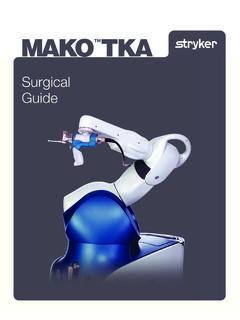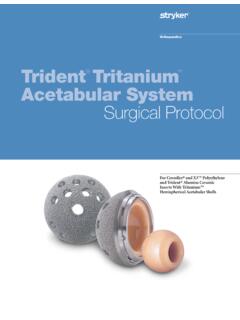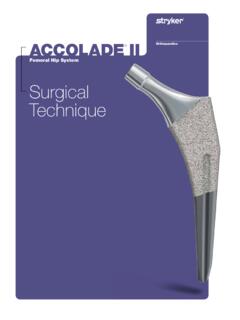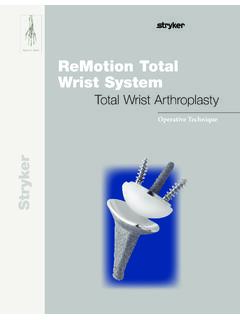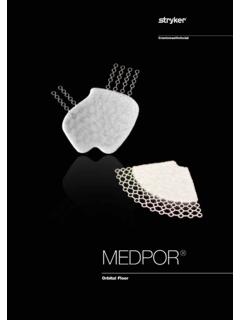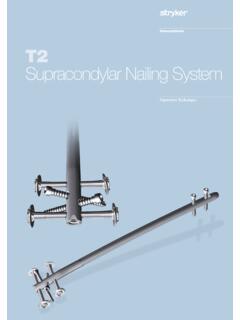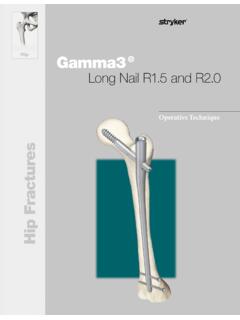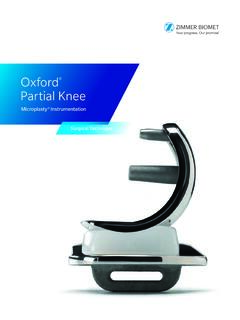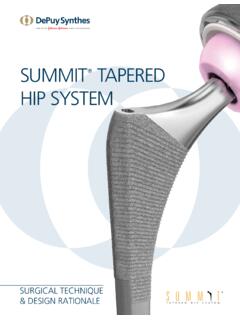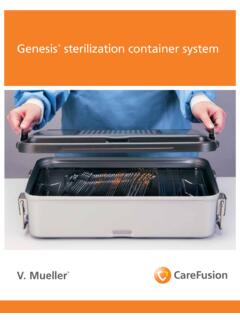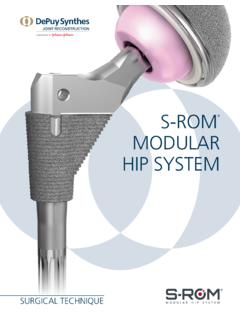Transcription of Triathlon Knee System Surgical Protocol - Stryker MedEd
1 Triathlon Knee Sy stem Surgical ProtocolPosterior Stabilized & Cruciate RetainingPosterior Stabilized & Cruciate RetainingThis document is intended to be used by healthcare professionals ..2 Exposure ..4 Femoral Preparation ..4 Femoral Intramedullary Alignment ..4 Femoral Sizing ..6 Femoral Anterior, Posterior, and Chamfer Resections ..8PS Box Preparation ..9 Femoral Trial Assessment ..14 Tibial Preparation ..16 Option 1 Extramedullary Referencing ..16 Flexion/Extension Alignment ..16 Varus/Valgus Alignment ..17 Tibial Slope Adjustment ..17 Rotational Alignment.
2 17 Option 2 Intramedullary Referencing ..18 Rotational Alignment ..18 Varus/Valgus Alignment ..19 Establish Tibial Resection Level ..20 Tibial Resection ..20 Tibial Component Sizing ..21 Tibial Keel Punching ..22 Patellar Preparation ..24 Trial Assessment ..24 Component Implantation ..25 Femoral Component - Cemented/Cementless ..25 Primary Tibial Baseplate - Cemented/Cementless ..26 Tibial Insert ..26 Patellar Component - Cemented/Cementless ..26 Closure ..27 Catalog ..28 Triathlon Knee System Surgical ProtocolAcknowledgmentsStryker Orthopaedics wishes to thank the global Triathlon Knee System Surgeon Panel for their dedication to the development and refinement of the Triathlon Knee System and Knee System Surgical ProtocolIndicationsGeneral Total Knee Arthroplasty (TKA) Indications include: Painful, disabling joint disease of the knee resulting from: non-inflammatory degenerative joint disease (including osteoarthritis, traumatic arthritis or avascular necrosis) rheumatoid arthritis or post-traumatic arthritis.
3 Post-traumatic loss of knee joint configuration and function. Moderate varus, valgus, or flexion deformity in which the ligamentous structures can be returned to adequate function and stability. Revision of previous unsuccessful knee replacement or other procedure. Fracture of the distal femur and/or proximal tibia that cannot be stabilized by standard fracture management Indications for Posterior Stabilized (PS) Components: Ligamentous instability requiring implant bearing surface geometries with increased constraint. Absent or non-functioning posterior cruciate ligament.
4 Severe anteroposterior instability of the knee Triathlon Total Knee System beaded and beaded with Peri-Apatite components are intended for uncemented use Triathlon Tritanium Tibial Baseplate and Tritanium Metal-Backed Patella components are indicated for both uncemented and cemented Any active or suspected latent infection in or about the knee joint. Distant foci of infection which may cause hematogenous spread to the implant site. Any mental or neuromuscular disorder which would create an unacceptable risk of prosthesis instability, prosthesis fixation failure, or complications in post-operative care.
5 Bone stock compromised by disease, infection or prior implantation which cannot provide adequate support and/or fixation to the prosthesis. Skeletal immaturity. Severe instability of the knee joint secondary to the absence of collateral ligament integrity and package insert for warnings, precautions, adverse effects, information for patients and other essential product information. Before using Triathlon instrumentation , verify: Instruments have been properly disassembled prior to cleaning and sterilization; Instruments have been properly assembled post-sterilization; Instruments have maintained design integrity; and, Proper size configurations are available.
6 For Instructions for Cleaning, Sterilization, Inspection and Maintenance of Orthopaedic Medical Devices, refer to 1 Figure 2 Figure 3 Exposure> A standard anterior mid-line incision is utilized. Any previous incision can be used or incorporated to decrease the risk of skin slough. > The capsule is entered through a medial parapatellar PreparationFemoral Intramedullary Alignment> The Universal Driver allows for attachment of all drills and pins. The Universal Driver may be attached directly to a reamer, drill, or a Jacob s Chuck. > Locate the IM drill hole.
7 It is approximately 1cm anterior to the femoral attachment of the posterior cruciate ligament and slightly medial to the mid-line of the distal femur.> Attach the 3/8 IM Drill to the Universal Driver and drill into the IM canal. The first diameter will create a tight fit around the IM Rod. If further clearance is desired, continue to drill until the larger step diameter opens the hole.> Attach the T-Handle Driver to the 5/16 IM Rod. Insert the IM Rod into the Femoral Alignment Guide. The Femoral Alignment Guide is designed for use on either the left or right knee and may be set to 5, 6 or 7 of valgus.
8 Set the instrument to the desired angle by pulling back on the black knob of the Femoral Alignment Guide and placing it in the appropriate notch. Advance the rod, with attached guide, slowly up the IM canal until the desired depth is Knee System Surgical ProtocolFemoralPreparation6541-4-801 Universal Driver6541-4-5383/8 IM Drill6541-4-800T-Handle DriverFigure 4 Instrument Bar5> Snap the Universal Resection Guide onto the Adjustment Block and insert the posts of the Adjustment Block into the two holes in the Femoral Alignment Guide.> Place the Femoral Alignment Guide in contact with the more prominent distal femoral condyle and align the guide in neutral position.
9 > Impact the distal captured pins in the Femoral Alignment Guide to aid in : Impacting a distal capture pin that does not make contact with the femoral condyle may result in a change in the alignment setting.> Pin the Distal Resection Guide to the anterior IM Rod6541-1-657 Femoral Alignment Guide6541-1-600 Adjustment Block 6541-1-721 Universal Resection GuideFigure 5 Figure 6 Figure 7> After the Universal Resection Guide is pinned in place, remove the IM Rod. The Femoral Alignment Guide and the Adjustment Block may be removed by squeezing the black tabs on the Adjustment Block.
10 > The distal femoral resection is made. An optional Modular Capture - may be attached to the Universal Resection Guide. Squeeze the black tabs on the Modular Capture - Distal Resection to insert into the Universal Resection Guide. When using a modular capture, a .050 ( ) blade is used.> Remove the Modular Capture and check the resection for flatness. Remove the Universal Resection Guide.> The Adjustment Block allows for an 8mm (the distal thickness of the femoral component) and 10mm (used to aid in the correction of a flexion contracture) resection level. Press the black button on the end of the Adjustment Block and pull to set the resection to the desired level.
